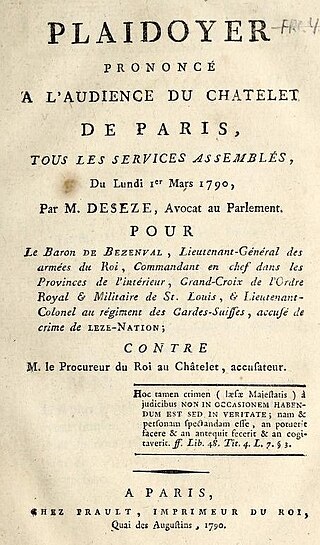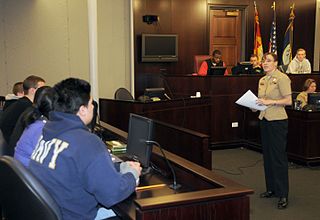Related Research Articles

A barrister is a type of lawyer in common law jurisdictions. Barristers mostly specialize in courtroom advocacy and litigation. Their tasks include arguing cases in courts and tribunals, drafting legal pleadings, researching the law and giving legal opinions.

In law, cross-examination is the interrogation of a witness by one's opponent. It is preceded by direct examination and may be followed by a redirect. A redirect examination, performed by the attorney or pro se individual who performed the direct examination, clarifies the witness' testimony provided during cross-examination including any subject matter raised during cross-examination but not discussed during direct examination. Recross examination addresses the witness' testimony discussed in redirect by the opponent. Depending on the judge's discretion, opponents are allowed multiple opportunities to redirect and recross examine witnesses.
The direct examination or examination-in-chief is one stage in the process of adducing evidence from witnesses in a court of law. Direct examination is the questioning of a witness by the lawyer/side/party that called such witness in a trial. Direct examination is usually performed to elicit evidence in support of facts which will satisfy a required element of a party's claim or defense.
A hostile witness, also known as an adverse witness or an unfavorable witness, is a witness at trial whose testimony on direct examination is either openly antagonistic or appears to be contrary to the legal position of the party who called the witness. This concept is used in the legal proceedings in the United States, and analogues of it exist in other legal systems in Western countries.
A lawsuit is a proceeding by one or more parties against one or more parties in a civil court of law. The archaic term "suit in law" is found in only a small number of laws still in effect today. The term "lawsuit" is used with respect to a civil action brought by a plaintiff who requests a legal remedy or equitable remedy from a court. The defendant is required to respond to the plaintiff's complaint or else risk default judgment. If the plaintiff is successful, judgment is entered in favor of the plaintiff, and the Court may impose the legal and/or equitable remedies available against the defendant (respondent). A variety of court orders may be issued in connection with or as part of the judgment to enforce a right, award damages or restitution, or impose a temporary or permanent injunction to prevent an act or compel an act. A declaratory judgment may be issued to prevent future legal disputes.

John Richard Boyd was a United States Air Force fighter pilot and Pentagon consultant during the second half of the 20th century. His theories have been highly influential in military, business, and litigation strategies and planning.

The OODA loop is a decision-making model developed by United States Air Force Colonel John Boyd. He applied the concept to the combat operations process, often at the operational level during military campaigns. It is often applied to understand commercial operations and learning processes. The approach explains how agility can overcome raw power in dealing with human opponents.

Res judicata or res iudicata, also known as claim preclusion, is the Latin term for judged matter, and refers to either of two concepts in common law civil procedure: a case in which there has been a final judgment and that is no longer subject to appeal; and the legal doctrine meant to bar relitigation of a claim between the same parties.

Maneuver warfare, or manoeuvre warfare, is a military strategy which emphasizes movement, initiative and surprise to achieve a position of advantage. Maneuver seeks to inflict losses indirectly by envelopment, encirclement and disruption, while minimizing the need to engage in frontal combat. In contrast to attrition warfare where strength tends to be applied against strength, maneuver warfare attempts to apply strength against weakness in order to accomplish the mission.

A closing argument, summation, or summing up is the concluding statement of each party's counsel reiterating the important arguments for the trier of fact, often the jury, in a court case. A closing argument occurs after the presentation of evidence. A closing argument may not contain any new information and may only use evidence introduced at trial. It is not customary to raise objections during closing arguments, except for egregious behavior. However, such objections, when made, can prove critical later in order to preserve appellate issues.

An opening statement is generally the first occasion that the trier of fact has to hear from a lawyer in a trial, aside possibly from questioning during voir dire. The opening statement is generally constructed to serve as a "road map" for the fact-finder. This is especially essential, in many jury trials, since jurors know nothing at all about the case before the trial,. Though such statements may be dramatic and vivid, they must be limited to the evidence reasonably expected to be presented during the trial. Attorneys generally conclude opening statements with a reminder that at the conclusion of evidence, the attorney will return to ask the fact-finder to find in his or her client's favor.
In United States law, multidistrict litigation (MDL) refers to a special federal legal procedure designed to speed the process for handling complex cases with numerous plaintiffs making similar claims, such as air disaster litigation or complex product liability suits.
Trial advocacy is the branch of knowledge concerned with making attorneys and other advocates more effective in trial proceedings. Trial advocacy is an essential trade skill for litigators and is taught in law schools and continuing legal education programs. It may also be taught in primary, secondary, and undergraduate schools, usually as a mock trial elective.
Richard C. Waites, J.D., Ph.D.,, a noted board certified trial attorney and social psychologist, is an internationally recognized expert in jury and courtroom decision maker research, a field he helped to develop and that he continues to advance.
Rosenman & Colin LLP was a New York City-based law firm that practiced from 1912 to 2002, at which point the firm merged with Chicago-based Katten Muchin Zavis to form Katten Muchin Rosenman. The firm previously practiced under the name Rosenman, Colin, Freund, Lewis & Cohen.

Daniel K. Webb is an American lawyer and public official. He is the co-executive chairman of the international law firm of Winston & Strawn. He is a former United States Attorney for the Northern District of Illinois and previously served as the Special Counsel in the Iran-Contra affair. As the United States Attorney for the Northern District of Illinois, he was the top federal law enforcement official in the city of Chicago on behalf of the United States Department of Justice. As U.S. Attorney, Webb led Operation Greylord and successfully prosecuted 76 corrupt judges, police officers, court clerks, and lawyers.
Eric Gibbs is an American attorney at Gibbs Law Group LLP in the United States. He is a member of the Board of Governors of the Consumer Attorneys of California. As a part of the American Association for Justice, he co-chairs the Consumer Privacy and Data Breach Litigation Group and the Lumber Liquidators Litigation Group, and serves as the secretary for the Qui Tam Litigation Group.

Ervin A. Gonzalez was an American civil trial attorney whose practice focused on wrongful death, personal injury, medical negligence, product liability and class action torts. He was a partner with the law firm Colson Hicks Eidson in the firm's Coral Gables office.

Strategic litigation, also known as impact litigation, is the practice of bringing lawsuits intended to affect societal change. Impact litigation cases may be class action lawsuits or individual claims with broader significance, and may rely on statutory law arguments or on constitutional claims. Such litigation has been widely and successfully used to influence public policy, especially by left-leaning groups, and often attracts significant media attention. One prominent instance of this practice is Brown v. Board of Education.
References
- ↑ Dreier, A.S., Strategy, Planning & Litigating to Win, pp. 54–5
- ↑ Selby-Dreier Debate on Advocacy Teaching
- ↑ See e.g. Id.
- ↑ Google: Define Strategy
- ↑ In The Art of War, for example, Sun Tzu observes: "In battle, there are not more than two methods of attack – the direct and the indirect; yet these two in combination give rise to an endless series of maneuvers." Giles trans p. 41
- ↑ Dreier, p.20
- ↑ See, e.g. Indiana Univ. Law School web site , at sec. (C)(3), accessed March 14, 2013
- ↑ Lubet, Steven, Modern Trial Advocacy pp. 8–10
- ↑ Mauet, Thomas A., Trial Notebook p. 13
- ↑ Dreier, pp. 20–4
- ↑ id. at 81–3
- ↑ Id. at pp. 79–85
- ↑ Id. at pp. 74–85
- ↑ Id. at pp. 46–73
- ↑ Id. at pp. 86–7
- ↑ Id. at pp. 51–5
- ↑ Id. at p. 55–70